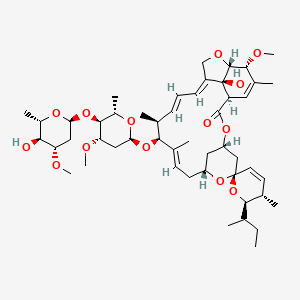| Gill JH and Redwin JM |
Cryopreservation of the first-stage larvae of trichostrongylid nematode parasites. |
1995 |
Int. J. Parasitol. |
pmid:8719953
|
| Herd R |
Ecotoxicity of the avermectins: a reply to Forbes. |
1996 |
Int. J. Parasitol. |
pmid:8818740
|
| Venkatachalam MA et al. |
Cytoprotection of kidney epithelial cells by compounds that target amino acid gated chloride channels. |
1996 |
Kidney Int. |
pmid:8821829
|
| Titchener RN and Purnell RE |
Duration of persistence of injectable avermectins against sucking lice of cattle. |
1996 |
Vet. Rec. |
pmid:8903014
|
| McKellar QA and Benchaoui HA |
Avermectins and milbemycins. |
1996 |
J. Vet. Pharmacol. Ther. |
pmid:8905567
|
| Shoop WL et al. |
Efficacy in sheep and pharmacokinetics in cattle that led to the selection of eprinomectin as a topical endectocide for cattle. |
1996 |
Int. J. Parasitol. |
pmid:9024866
|
| Shoop WL et al. |
Eprinomectin: a novel avermectin for use as a topical endectocide for cattle. |
1996 |
Int. J. Parasitol. |
pmid:9024867
|
| Krieger RI et al. |
Adult and infant abamectin exposures following Avert 310 and pressurized gel crack and crevice treatment. |
1997 |
Bull Environ Contam Toxicol |
pmid:9115128
|
| Vassilatis DK et al. |
Evolutionary relationship of the ligand-gated ion channels and the avermectin-sensitive, glutamate-gated chloride channels. |
1997 |
J. Mol. Evol. |
pmid:9115174
|
| Gray AK |
Avermectin toxicity in the dog. |
1997 |
Vet. Rec. |
pmid:9185316
|
| Scarff DH |
Avermectin toxicity in the dog. |
1997 |
Vet. Rec. |
pmid:9185317
|
| Pomes A et al. |
Target size analysis of an avermectin binding site from Drosophila melanogaster. |
1997 |
Biochim. Biophys. Acta |
pmid:9187243
|
| Laughton DL et al. |
Reporter gene constructs suggest that the Caenorhabditis elegans avermectin receptor beta-subunit is expressed solely in the pharynx. |
1997 |
J. Exp. Biol. |
pmid:9192499
|
| Doody GM |
Avermectin toxicity in the dog. |
1997 |
Vet. Rec. |
pmid:9203324
|
| Mironov VA et al. |
[Biosynthesis of avermectins: physiological and technological aspects]. |
1997 |
Antibiot. Khimioter. |
pmid:9265465
|
| Lonneux JF et al. |
Antibody response after treatment in cattle infected with Psoroptes ovis. |
1997 Jul-Aug |
Res. Vet. Sci. |
pmid:9368957
|
| Barnes TM and Hekimi S |
The Caenorhabditis elegans avermectin resistance and anesthetic response gene unc-9 encodes a member of a protein family implicated in electrical coupling of excitable cells. |
1997 |
J. Neurochem. |
pmid:9375655
|
| Vassilatis DK et al. |
Genetic and biochemical evidence for a novel avermectin-sensitive chloride channel in Caenorhabditis elegans. Isolation and characterization. |
1997 |
J. Biol. Chem. |
pmid:9407104
|
| Marsden AF et al. |
Engineering broader specificity into an antibiotic-producing polyketide synthase. |
1998 |
Science |
pmid:9422686
|
| Ikeda H et al. |
Cloning of the gene encoding avermectin B 5-O-methyltransferase in avermectin-producing Streptomyces avermitilis. |
1998 |
Gene |
pmid:9469930
|
| Gill JH et al. |
Evidence of multiple mechanisms of avermectin resistance in haemonchus contortus--comparison of selection protocols. |
1998 |
Int. J. Parasitol. |
pmid:9650059
|
| Lonneux JF et al. |
The relationship between parasite counts, lesions, antibody titres and daily weight gains in Psoroptes ovis infested cattle. |
1998 |
Vet. Parasitol. |
pmid:9653998
|
| Gill JH and Lacey E |
Avermectin/milbemycin resistance in trichostrongyloid nematodes. |
1998 |
Int. J. Parasitol. |
pmid:9673866
|
| Lankas GR et al. |
Placental P-glycoprotein deficiency enhances susceptibility to chemically induced birth defects in mice. |
1998 Jul-Aug |
Reprod. Toxicol. |
pmid:9717696
|
| Delany NS et al. |
Cloning and localisation of an avermectin receptor-related subunit from Haemonchus contortus. |
1998 |
Mol. Biochem. Parasitol. |
pmid:9879896
|
| Windelspecht M et al. |
Survey of malathion resistance and avermectin susceptibility in field populations of Drosophila melanogaster (Diptera: Drosophilidae) and D. simulans. |
1998 |
J. Econ. Entomol. |
pmid:9887681
|
| Meinke PT et al. |
Synthesis of gem-difluoro-avermectin derivatives: potent anthelmintic and anticonvulsant agents. |
1998 |
Bioorg. Med. Chem. Lett. |
pmid:9934486
|
